#tried a different browser and got an authentication error
Explore tagged Tumblr posts
Text
why is gmail such a pain in the ass every single time something goes wrong
Edit: nvm if I do it from the browser to start with, I can get in just fine. it's jsut outlook causing an issue or something idk
#missy rambles#tried opening outlook to check all my emails and all my gmails need ''attention''#but if i try they get stuck on the verification. tried turning off ublock. nothing.#tried a different browser and got an authentication error#UUGHGH
0 notes
Text
Top View Server State Permission Reviews!
Login failed for user is just one of the most typical error which everyone may have seen at least one time. It is possible to now ask your user to check the script again. Logging in via SSH will assist the user to develop into the main user. In the event the user doesn't approve the request, the response consists of an error message. In some cases he may wish to revoke access given to an application. Likewise, a user who doesn't subscribe to TopicA doesn't obtain the message. Today's web browsers permit you to download files via FTP from inside the browser window.
SQL Server deliberately hides the character of the authentication error and provides State 1. Some servers are very popular, therefore it may take you a couple of tries to get access. Most servers on the net have a large number of such doors, each with its own function. Although your client will take care of all of the server commands for you, an excellent Monkey ought to be able to consider the logs and understand what's happening. So far as stand-alone FTP clients go, in fact, there are hundreds out there. App server is going to receive a nack response. The XMPP connection server stipulates a few other alternatives for responses.
The procedure is unkillable, because it is in a `Critical Section' and doesn't respond to kill. An easy-to-use and entirely free application named FileZilla is an excellent place to get started. Naturally, there has to be an internet server on your computer, and your firewall software (for example, Windows XP Personal Firewall) has to be set to permit incoming connections on port 80 from different computers on the network. There's some great software on the Free Software Foundation servers. A program or mechanism that allows the essential processes for file sharing can likewise be referred to as a file server. An error concerning security occurred. Otherwise you'll get an error message. The request was accepted by management. Please be aware that you want the VIEW SERVER STATE permission to look at all sessions.
You have to recommend an approach for identifying queries which don't complete. In case you have any queries with Windows, don't hesitate to reply and we'll be pleased to assist. Databases have become larger and larger. If you would like to audit only 1 database, you'll need to define a Database Audit Specification in that particular database. If you've got the Northwind database you may observe it has several views installed by default. Since you can see above that LOG folder includes many files. Binary files, on the flip side, are structured differently, and for that reason take a different manner of transfer.
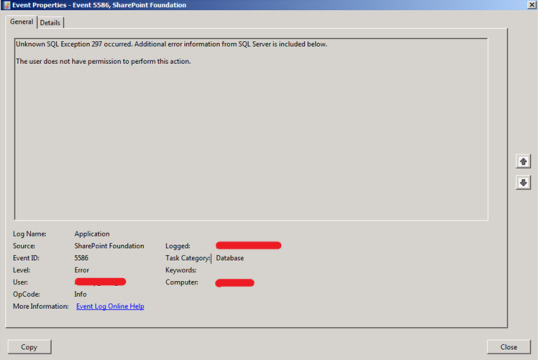
How to Find View Server State Permission
An answer choice could possibly be correct for at least 1 question in the set. Or, in the instance of wanting a particular permission on a particular object, our only option appears to be granting that permission on all objects, or perhaps even across all Databases. Internal people have the choice of clicking the guest link and accessing the website or document without needing to sign in, and external folks who receive a guest link have a one-time redemption link they can utilize to access the website or document.
If you wish to find out who already has access to a specific website, simply go to the Settings menu in top right corner, click Shared with, and you'll observe the names and pictures of individuals who have access to the website. File access should have the very best possible read and write performance. In the User Mapping menu section which offers you accessibility to the Database Level permissions, make certain you choose the database you wish to provide the user backup permissions to. view server state permission Requesting offline access is a requirement for virtually any application that has to access a Google API whenever the user isn't present. You must return information regarding processes which are not idle, that belong to a particular user, or that belong to a particular session. Confirm standard user information is accurate.
Each question in the series comprises a distinctive solution that may satisfy the stated goals. Don't hesitate to contact me in case you have any questions. Try to remember, in case you have questions regarding voting (or anything else) you always have the option to Ask a Librarian! The solution is to determine, before you operate the backup, if it's the differential or transaction log backup can be done. It isn't as alarming as you believe. The SQL Server Maintenance Solution was designed to do integrity checks of quite huge databases. The code samples below also demonstrate the code that you must add to use incremental authorization.
A view includes rows and columns, exactly like a true table. You may also switch from the cell view to see site pages in the complete web view which you would see on a desktop computer. As any of you using View already know, there are plenty of actions that should be undertaken before your environment is prepared for prime moment. Dynamic management views and functions are organized into these categories.
youtube
1 note
·
View note
Text
300+ TOP Web Services Testing Interview Questions and Answers
Web Services Testing Interview Questions for freshers experienced :-
1. Difference between Web application and web service? A web application is a database disc. A web service is a online service, as in Verizon online service, Web application: any application which resides on a server, but meant for use by humans, which uses web pages as the presentation layer. All user interactivity (the GUI) is done through web pages, but all data is stored and (mostly) manipulated on the server. Web service: server-based application (as above) which may be accessed over the web via HTTP, but is meant primarily for interaction with other programs. Thus, it will have a clearly-defined API which consists of providing responses to HTTP GET and POST requests made by a remote application. 2. What are the typical problems in web testing? server problems(ie server down or under maintenance) HardWare problem DataBase problem 3. In n tier Architecture What are the factors should be considered for testing? Basically 3-tier architecture is for windows based application. Whereas n-tier architecture is for web-based applications. So, We should do the testing related to web-testing. In 3 tier architecture there are 3 layers in the architecture. They are 1) Application(Presentation) layer 2)Business Logic Layer and 3)Data layer In n tier architecture, Data layer is divided into 2 layers i.e Data access and Database. In n tier architecture, Data access layer and Database layer may or may not reside on the same location. Keeping that into consideration we have to prepare Test strategy and Test Approach. 4. What types of web testing security problem? Denial of Service (DoS) attack, buffer overflow. Pasting internal url directly into browser address bar without login. Check reactions for invalid inputs for login id and password User should not view the other stats. 5. What bugs are mainly come in webtesting what severity and priority we are giving The bug that mainly comes in web testing are cosmetic bugs on web pages , field validation related bugs and also the bugs related to scalability ,throughput and response time for web pages. During the website application testing, bug related to the link broken also comes. 6. What are the important test scenarios for testing a web site? As a Tester you should test GUI of the website, test whether the page layout and design elements are consistent throughout the site, Whether all the links provided in the website are working properly, What are the expected loads on the server performance of the website (check for webserver response time and database query time)under heavy loads. As a Test Engineer you should also test the functionality of each and every object existing in the web page while testing a web application 7. What is Glyphs? Glyph is the picture of the character. 8. What is the difference of approach for Testing Client/server and web applications? In case of web based testing we have test web browser and pages but in case of client server testing we test icon of application that is main difference Web based Application follows the client Server Architecture. Since in web based, we have a client i.e. Browser itself and the server is at some remote location. There is no such difference between client server and web based but it can be said that applications that are based on the client server architecture are different. Eg. Window based application - in them we need to install the application at each of the client user interface server being common for all the clients. but in web based application for user interface there is no need for any installation. The browser is the client itself. 9. What are possible configurations that could affect the testing strategy of any web site? Hardware platform (PC, Mac), Browser software and version, Browser Plug-Ins, Browser settings options, Video resolution and Color Depth, text size. 10. What is the difference between testing in client-server applications and web based applications? Client Server Testing:- In client server testing test engineer are conduct the following testing’s:- Behaviour testing(GUI TESTING) Input domain testing Error Handling testing Backend testing In Web testing test engineer are conduct the following testings:- Behaviour Testing Static web testing Input domain testing Backend testing Error handling testing Frame Level testing

Web Services Testing Interview Questions 11. What type of testing is carried out to find memory- leakages? give me a sample example? Through Volume testing it is possible. i.e., An application tries to retrieve large amount of data that require large temporary buffer area. If the data exceed the buffer area the situation of memory leakage will occur and query will fail without returning any result as sorting didn’t got finished as buffer exceeds the limit. We need to know the memory size before the test execution and after test execution by using memory related API functions or MFC functions. 12. What is the difference between web application And Client server Application Testing? While Testing the Web Browser we need to take care of Security, Usability, Performance and URL links. Web application is internationally so security is very important here. Where as Client server we don’t need security at high level, It is two tier and it is used only by defined users. 13. What is your approach or how do you start Testing an Web application? The first thing u need is to go through the specification and without using the specification u are just playing with the application. So specification is the main interface to the for any software to be tested First Do The GUI testing after finishing that we can go for Functionality Testing. 14. How to Check whether your website is secure or not? Microsoft Internet Explorer displays the lock icon in the lower-right of the browser window Many SSL Certificate vendors (Verisign, GeoTrust, etc.) also provide a "site seal" to the owners of these web sites. 15. What are the typical problems in web testing? In the web testing the main problems with SERVER security the security testing plays imp role. 16. In n tier Architecture what are the factors should be considered for testing? In N tier architecture, load testing, browser testing, compatible testing and functional testing are mandatory factor. 17. What are the common problems encountered in web testing? The most common problem encountered during testing network is the server problem. The server may be down or may be subject to maintenance. The next problem, which is often found in testing site is a database problem, where the connection with the broken base. In some cases there may be hardware compatibility issues when you are testing a Web application. 18. What are the different static websites to dynamic websites? Static web pages only give information to the user and the user does not have any interaction with the website. On the other hand, dynamic Web sites are those where the user communicates with the system and they are required information. In providing the required information, you may be able to retrieve the information you are looking for. 19. What are the most common browsers, which must be a Web application to test? The commonly used browsers are Mozilla Firefox, Google Chrome, Internet Explorer and Opera. Therefore, a Web application must be tested in these browsers as well. 20.While testing a web site, which are different configurations that have to be aware of? These settings can demand change in the strategy of the website. The most important factor to consider is the hardware platform, while some may use the Mac platform, some may use Linux, while others can use the Microsoft. The next is the browsers and their versions in the box. Along with the browser versions, different plug-ins must also be considered. The resolution also monitor color depth and size of the text are some of the other configurations. 21. Is it possible, while usability testing a website? Usability testing is in fact an important part of the test site. In usability testing, it checks if the website is easy to use. Is it possible that the user can move easily within the website. Is there any ambiguity in the website, which can make the user experience. 22. What is a proxy server? A proxy server is a server, which acts as an intermediary between the client and the server. Therefore, applications on the primary server is first sent to the proxy server on the client system, which is then sent to the server. The response from the principal server sends the client through the proxy server. The application and / or response can be modified by the proxy server based on filter rules from the server. 23. What are the HTTP response object? Some of the HTTP response objects are writing, cleaning, counting, etc. HTTP response subclasses are HttpResponseRedirect, HttpResponsePermanentRedirect, HttpResponseBadRequest, HttpResponseNotFound, etc. 24. What are the different test formats for cases, which are part of the test site? The test case format may vary depending on whether the site is a static website or dynamic website. The static website will have the front of the test cases, test cases, navigation. On the other hand, if the site is a dynamic web site, then test cases are divided into front end test cases, again the final test cases, the field validation test cases, case base test data, test cases, security, etc. 25. Explain the difference between authentication and authorization for web testing? Authentication is the process by which the system identifies the user. The aim is to ensure that the user is actually a user who claims to be. There are different types of authentication, which can be used as password-based authentication, authentication based devices, etc. On the other hand, the authorization is the process after the authentication process. In this process the system to decide whether a particular task can be performed by the user, does the necessary permissions, etc. 26. Different test scenarios do you consider when you are testing a Web site? The first hypothesis to check is the graphical user interface. Page layout and design elements used on the website must be uniform throughout the website. The next part of the test are always different links within the website. Along with links, but they also have to be tested, if the navigation is soft and also to check if there is complex. The next important aspect to control is the response time of the website. This will also have to check when there is heavy load on the system. Web Services Testing Questions and Answers Pdf Download Read the full article
0 notes
Text
Lessons from a software project
I am adding to my usual weekly rotation of posts to write about a software project that I recently (almost) finished. I want to get my thoughts down now while it is fresh in my mind.
Project Overview
The project is a bug tracker. It is online here. The GitHub repo is here. It is a simple, classic bug tracker. The app allows teams to define several projects and maintain a list of outstanding issues for each project, assigned by user. Project managers and issue owners can mark issues as complete. An individual could use it as a personal to-do list as well. The mail element of the technology stack are as follows.
- React frontend, generated with create-react-app. It is a single page app with all the app’s functionality. It is implemented on GitHub pages.
- Auth0 for authentication.
- A Node backend. It handles api calls to the database. It is deployed on an Amazon Web Services EC2 t2.micro instance running Amazon Linux 2.
- PostgresQL database. It stores user data and data about teams, projects, and issues. It is implemented with an Amazon RDS t3.micro instance.
- SB Admin 2, a Bootstrap theme, for styling.
The purpose of this project is to serve as a portfolio piece indicating that I am capable of full stack development. As such I think it is a good step and the best full stack project I have done so far, but I think I can do better next time. Some of the ways I can do better are detailed below.
Functionality
The functionality of the app is fairly limited relative to what I wanted. It allows creation and deletion of teams, projects, and issues, as well as completion of issues by their owners. I would have liked to add timestamps for issue creation and due date; some sorting functionality; and mechanisms for modifying teams, projects, and issues without deleting and recreating them, but I ran out of time that I was willing to devote to the project.
I’ve tested the project extensively locally, but there are so many variables in the deployment that I don’t know how it is going to survive in the wild. We will see.
There are a couple things that I don’t think are quite right but do not seem to be major problems and that I gave up worrying about. For one thing, the front end seems to be firing off more API calls than I think it should be. I’m pretty sure it has something to do with React’s useEffect being triggered more often than I want, but I did not figure out the precise reason in the course of investigating. There were a couple of icons that are part of the SB Admin 2 theme that for whatever reason I couldn’t get to appear properly, and I gave up on those.
Development
The main challenge in development was locally wiring up the various pieces. The actual programming of the app wasn’t too hard. This was my first project with PostgresQL, and I found the system to be straightforward enough. It was also my first attempt to use Auth0. I found the system to be challenging to use, though it provides much more functionality and ease of use for user than any authentication that I would be able to develop myself.
I have used Node many times before. I like it and find it straightforward. The app in this case is fairly simple and primarily serves the function of interfacing between the front end and the database. In theory I think I could have made database calls directly from the front end, but that doesn’t seem like a good design decision.
I’ve done a few React apps, all with create-react-app. I think that was a mistake. I’ve been using create-react-app as a crutch. The system brings about some serious bloatware. The next time I do something with React, I should find an alternative way to develop and deploy the app. Beyond that, my system of passing parameters through the app is also a bit of a mess. I believe Redux would help streamline that process, and Redux is on my todo list, but it is not something I am familiar with yet. I used a few class components, but I think I should have just kicked that habit and done everything with function components; I see no reason why I couldn’t have.
SB Admin 2 was a pleasure to use. Design isn’t my strongest suit, nor is it primarily what I wanted to illustrate with this project. Going off the project template, I found it easy to make an app that looks presentable. I’m a little dissatisfied with the color scheme, which has something of that “corporate kindergarten” aesthetic to it, but that is acceptable.
Deployment
Actually putting this thing online so others could use it was a major time sink and source of frustration learning experience. I noted in last week’s blog post that this endeavor falls under the job description of a DevOps person, which is not what I am aspiring to be. DevOps is its own form of problem solving, which for the right person could be a lot fun. It also commands a market premium for people who have those skills. I now see very clearly why.
I made a very big mistake that I will not be repeating on future projects. I tried to develop everything locally and get full app functionality locally before taking on deployment. Worse, I tried to treat the entire project as a single package. I was not, for instance, planning on using AWS RDS for the database. I had set up PostgresQL on my local machine and tried to do the same on the EC2 instance. I was also planning on building and running the React frontend out of the same instance.
Almost none of this worked. I installed PostgresQL on the EC2 instance, and it seemed to work for a while, but after a while I couldn’t connect at all. Repeatedly uninstalling and reinstalling the database just caused the DevOps gods to laugh. It was only then that I decided to separate the database to RDS. Even then, somehow the pq module (the Node modules that connects to a PostgresQL database) got borked and I had to uninstall and reinstall it to get that working.
I also tried to run the Node and React apps out of a single concurrently instance. Again, it worked fine locally but failed on deployment. I still don’t fully understand why it didn’t work. Part of the problem was security. For whatever reason React wanted to build to an HTTP instead of an HTTPS deploy, which Chrome flagged as a security hazard. I struggled to figure out how to add an SSL certificate and that only seemed to partially solve the problem. Then I got a CORS (cross-origin resource sharing) error. I tried modifying the Node app to an HTTPS instead of an HTTP server, but that didn’t seem to solve the problem. Even now I’m still not sure it is working right. My browser loads the front end all right but still gives me a security flag.
There was also an issue of the proxy in packages.json not working. Again, it worked fine in dev but just flat out refused to work on the deploy. I gave up trying to figure out why and just started doing full URLs in the fetch requests.
It is obvious in retrospect, and for future projects, that I should have done one or both of two things:
1) Go for a modular design from the beginning. Now all the major pieces are in different places (except I deployed SB Admin 2 with the front end), and that leaves fewer opportunities for conflict. There was no reason not to plan it out that way from the beginning.
2) Figure out the deploy process at the outset. This is the “walking skeleton” methodology. I would add only the minimal “hello world” substance to each piece, then fully ship the project to demonstrate a working architecture. Then I go about building out the pieces. Had I done this at the start, it would have saved me a great deal of stress later on.
Some General Thoughts
The difficulty of a project grows superlinearly in the number of mutually interrelated components. This is probably the same basic mechanism that causes complex infrastructure projects to almost always go over schedule and budget. Modularity needs to be a watchword. I’ve learned my lesson on that.
In general I was pretty happy with AWS. The performance seems to be quite good. It wasn’t too hard to use. The AWS console is huge and can be difficult to navigate. Their system of traffic access rules is a bit confusing but was manageable.
People often complain about JavaScript development. I think the problem is not with JavaScript itself, but with the NPM zoo. Despite the allegedly modular design of NPM packages, the inscrutable chain of dependencies are such that they are inherently non-modular in practice. Reproducibility is a serious problem. Security is a problem. There are vulnerabilities such as shown in the left-pad incident. The system leads to bloatware. It fosters a bad habit of programmers pulling in packages for simple functions they could easily write themselves. The multiplicity of potential clashes between packages of different versions is a factor driving the development of virtual machines and containerization, tools which introduce their own inefficiencies through abstraction. There has got to be a better way. I wonder if there exists anything that be for JavaScript what Acaconda is for Python. There certainly should be.
Security and networking are two things that are important and I just don’t understand very well yet. I think this process would have been easier if I knew what was going on when those bugs came up.
What’s Ahead
For now I am taking a breather to celebrate the completion of this project. While there are some deficiencies in this latest project, I think the place to correct them is on the next project, rather than try to push this one any further. Eventually I want to plan out and execute another full stack project. I don’t know what it will look like yet, but it should be something more interesting than a bug tracker.
In the meantime, I am working through a JavaScript bootcamp and have fallen behind on the projects there. For my next portfolio piece, I want to do something more algorithms-oriented, where the challenge will be in the actual coding rather than in the DevOps.
0 notes
Text
This Indian firm wants to give you a reliable, more secure alternative to Zoom – tech
try { window._mNHandle.queue.push(function (){ window._mNDetails.loadTag("173377332", "300x250", "173377332"); }); } catch (error) {}
At a time after we can not meet one another and do the issues we usually did to keep in contact and converse, apps like WhatsApp, FaceTime, Skype, Google Hangouts, Google Duo, Blue Denims, Microsoft Groups, Zoom and so forth have come to our rescue. Caught at dwelling for a whereas now, video calls have turn out to be a mainstay for many of us. You is likely to be utilizing them to your workplace calls or to simply chat with family and friends.
Nevertheless, whereas some apps enable solely a few individuals to participate in a video/voice chat, others have been coping with a entire bunch of safety and privateness points. In all this, the necessity to discover a secure, steady alternative, ideally an indigenous one, has been rising.
Enter, Say Namaste.
Made by Mumbai-based mostly firm Inscripts, Say Namaste dropped into the scene simply a few days in the past and has already crossed half a million customers (5 lakhs). They’re including roughly one lakh customers per day.
For starters, let’s make it clear that Say Namaste isn’t the Indian authorities’s official video calling app. The federal government has referred to as on tech corporations to develop a secure alternative to Zoom and has declared prize cash of Rs 1 crore to the winner, and Say Namaste might be taking part. Nevertheless, the app is in it’s beta testing section for now, and might solely be accessed on-line, from saynamaste.in (More on this later).
Additionally Learn: Govt invitations tech corporations to construct a secure Zoom-alternative, winner to get Rs 1 crore
Inscripts was based by twin brothers Anuj and Anant Garg who’ve been within the enterprise of making communication merchandise for enterprises for the previous 10 years. The corporate claims it’s APIs (utility program interfaces) are utilized by numerous corporations for his or her video conferencing amenities, textual content chats and so forth.
Say Namaste, although, got here into being by likelihood, on a day when the crew was discussing privateness issues in video calls. Why isn’t there an Indian app? We want one, they thought, and the remainder, as they are saying, is (latest) historical past.
“We’ve developed this underlying expertise, now we have experience on this, why don’t we simply go construct our personal app? That was the genesis,” mentioned Anuj. So, the crew went forward and constructed a net app that they began utilizing to talk internally. “One among us advised Namaste and it instantly resonated with everybody,” Anuj mentioned, whereas speaking about the place the identify got here from. In accordance to him, this was the primary time the crew used its personal product as a buyer.
Anuj ultimately determined to put it on Fb in order that he may get some actual-world suggestions. He additionally despatched a few hyperlinks out on WhatsApp. Whereas the crew determined to sleep on it, a few days later Anuj was woken up to a entire barrage of texts about a firm that has launched a new video-conferencing app.
Overlook Zoom and others, use this Indian-made app….
Anuj realised that folks have been speaking about Say Namaste.
We’ve been working 24/7 to sustain with the demand, to see how we will scale this resolution, it’s a huge spike, mentioned Anuj.
“We’ve been serving enterprise clients up to now, we all know what it takes to serve these clients,” he mentioned including that when you transfer from catering to 5,000 clients to 500,000, it brings its personal set of challenges.
“We’ve labored with banks, medical companies and so forth, so privateness and safety are a a part of Inscript’s DNA,” Anuj defined. Whereas a lot of issues have been already in place, the corporate is now considering of the way to strengthen the app and to scale it. “Proper now all our efforts are in the direction of breaking our personal software program, so no one else can break it,” he added.
The ship is being constructed whereas they sail it, and the main focus is on conserving it quite simple — a one-click on video conferencing expertise from begin to the top. When one thing goes viral, you can not plan for it, you scale with it,” mentioned Anuj.
“My usability tester on that is my mom. So long as she will be able to determine it out it’s nice,” he mentioned. He goes again to the drafting board at any time when his mom says she will be able to’t perceive one thing on the app.
How does one use Say Namaste to chat?
As talked about above, you begin at saynamaste.in. Enter your identify and hit ‘begin assembly’. You share the main points of this assembly with anybody and as soon as it begins, they arrive on to the identical web site, enter their identify, the assembly ID, and the secure assembly code to be a part of. The assembly ID and a non-public assembly code are important to all calls, which retains folks from becoming a member of uninvited.
A one-click on video-conferencing resolution with servers in India, so information residency is assured. ( saynamaste.in )
The corporate claims that the positioning doesn’t gather your electronic mail ID, and it doesn’t ask you to log in with Fb or Google. You possibly can enter any identify you need to use for the assembly. “We’re solely gathering information that’s wanted to facilitate your name, like your IP tackle. However we use that over the period of the decision and it’s forgotten after that. We aren’t storing something on our servers proper now, no chats, nothing. We’re decreasing all these potentialities of safety breaches,” Anuj defined.
How secure is all of this?
Cyptographic requirements like AES 256 bit encryption and TLS (Transport Safety Layer) encryption are already in place, Anuj claims.
“All our information is encrypted at relaxation and encrypted at transmit. We even have our GDPR (Common Information Safety Regulation) compliance in place. Issues like 2FA (two-issue authentication) are being constructed and might be launched quickly, we’re nonetheless experimenting with it when it comes to how we ensure that the expertise isn’t damaged,” he added.
“Finish-to-end encryption will get thrown about like it’s the be-all and finish-all of safety, however that’s not the case. There are numerous, many elements that go into making a secure utility. Encryption is one in every of them and we’re encrypted,” mentioned Anuj.
The corporate is engaged on a lot of issues because it tries not solely to scale its product, but in addition to get all the safety protocols in place. “We’re within the means of getting a third-get together impartial audit performed. The concept is to begin determining what the chinks within the armour are,” Anuj defined.
The app is constructed for less complicated use instances proper now, however Anuj mentioned the corporate will add customised log-ins and authentication techniques (normally required for enterprise use instances) when the necessity arises.
The truth that Say Namaste relies in India means it’s servers are based mostly right here too, which is one other factor that the corporate hopes will set it aside from different video-conferencing apps. “Relying on how this strikes forward we’re additionally working with a few corporates as a pilot proper now, so we will work out particular wants and construct the safeguards right here as an alternative of getting it from outdoors India,” Anuj mentioned.
Whereas Anuj says that comparisons with Zoom, which is a multi million greenback firm, is unfair at this level, Inscript is conscious that it’s build up to tackle giants.
“We’re ensuring we study from others’ errors. Our focus proper now’s to be in tune with what our clients want,” Anuj mentioned.
How many individuals on a name then?
Anuj mentioned that they’ve been doing “actually good calls with about 25 individuals” and there are individuals who have performed calls with more individuals, their information reveals that, however they don’t seem to be positive how scalable that’s proper now.
The corporate’s goal is to attain 100 individuals. Nevertheless it doesn’t cease there. “It’s not purely a numerical factor. One additionally has to take a look at the use case. Like in a webinar, for a 1,000 individuals, you don’t essentially need everybody to use video. That’s a one-to-many form of a dialog as opposed to a many-to-many dialog — there are alternative ways to scale that,” he defined.
What can you not do on Say Namaste proper now?
Anuj mentioned the corporate is engaged on options that might be “recreation changers”, however there are nonetheless issues you can’t do on Say Namaste. At the very least for now.
For one, there isn’t a app proper now. Say Namaste is barely supported on laptops, desktops or Android telephones (not iOS) by the Chrome browser.
Its cellphone apps are being examined. “We’ve already revealed it on the Play Retailer and the App Retailer and despatched it for evaluate. Nevertheless it’s not out for the general public but,” Anuj mentioned. Moreover the apps, the crew may also be including more browser help.
Say Namaste is free proper now however there might be a premium mannequin in future for energy customers.
try { window._mNHandle.queue.push(function (){ window._mNDetails.loadTag("379748484", "160x600", "379748484"); }); } catch (error) {}
Source link
The post This Indian firm wants to give you a reliable, more secure alternative to Zoom – tech appeared first on Bharats Guide.
from WordPress https://ift.tt/2zDym7B via IFTTT
0 notes
Text
Hack This Site - Realistic #15


The submit questions and job forms were of interest to me initially but after watching the details of the POST request, I realised they couldn’t be abused. The header of the index page was also a bit interesting:

I clicked on some of the images and found a “/images” folder but couldn’t really find anything from there. Interestingly enough when you send a request in the jobs form, you actually get an image in a different directory:

Within the “_backups_” folder I found a “backups.zip” file which I downloaded and attempted to extract...
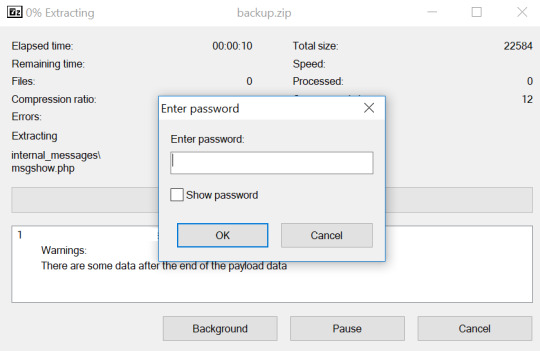
Unfortunately the damn thing is password-protected, so this challenge is definitely going to be more annoying than anticipated! Fortunately we can see the names of the files:

Now this is where it becomes interesting, because since it is a backup of the web server we will know some of the files in the archive. This means we can potentially perform a plaintext attack on the encrypted zip archive - there is a cool program called ‘PkCrack’ you can use to do this. The basic idea is you need to compress one of the plaintext files with the same compression format and level as as the original file. So I basically downloaded the ‘index.htm’ from the site and compressed it using the default Ubuntu ‘zip’ program:
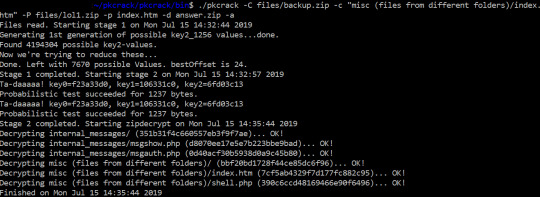
Basically it allows you to recover the keystream which is used for encrypting the files and thus recover the contents; however it is still a bit harder to get the actual key (luckily, we don’t need it here!). Looking into “/internal_messages/msgshow.php” we get:

And in “/internal_messages/msgauth.php”:

There was also a “internal_messages.php” file referred to which requires a password and uses these authentication scripts. Now the interesting thing about the 2nd excerpt is it is performing an expression match of a $username: $password - we saw something of a similar format in the header on the main page - it was “webadmin”: “Susy Slack”. I modified the ‘internal_messages.php’ form to post to ‘msgauth.php’ instead with these credentials and a specified file name.

Initially this didn’t work so I tried fiddling around with the variables but no matter what it didn’t seem to work... I then tried sending the POST request manually using a tool called Postman:

Initially when I tried with webadmin it didnt work but after fiddling around with the variables I got a combination which set the admin flag. The problem was this still didn’t let me access it through “internal_messages.php” as the app is running separate to the browser, so after transferring the cookies over I was able to view the message:

So basically we now know of the existence of a “/admin_area” directory however when I navigate to here it is showing as forbidden. I tried trying to get the directory contents via a number of means, but to no avail. Then I remembered that we had a ‘shell.php’ inside the encrypted zip file so I thought I would try and access it... the problem is it seems to require a username and password... Digging back into the ‘shell.php’ file we see this near the top:

So we know what the username is, but they have removed the password in the backup copy. Digging through the code a bit lower:
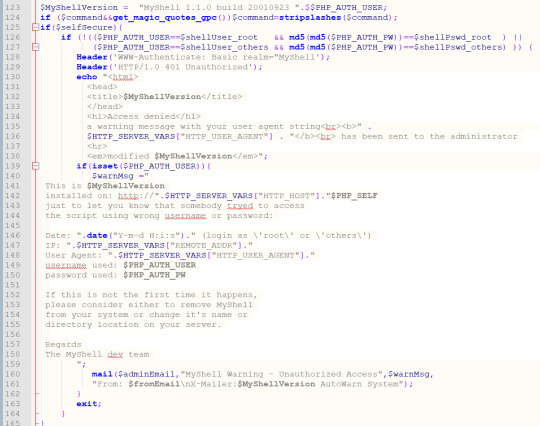
We see a section of the script which will display on a failed login. Interestingly enough they use a “$$PHP_AUTHUSER” in the returned string (at top of image) - this means that we can potentially inject into the username and grab variables from the file. Naturally I want to know “$shellPswd_root” so I entered “shellPswd_root” which gave me:

Cracking the hash we get the result:

Now I’m finally into the shell which I used to look at the directories:

I dug around in the directories but the only one of interest was “/test/” which contained the following zip:

Inside the zip file is a C program which seems to be used for validating usernames and passwords:

Funnily enough we had recently been literally looking at buffer overflows and this looks like one we can definitely abuse... Basically we want this routine to return ‘Y’ and to force it into doing this we need to fill the buffer with characters and overflow a ‘Y’ into the is_pass_correct. I basically had to do a bit of trial-and-error into the ‘viewpatents.php’ form as it doesn’t give me any outputs in return but I knew it couldn’t be too far over 200. The exact number was 224 characters which started overflowing the required ‘N’ character:

And this finally gave me access to the required patents! Mah gawd this challenge took forever...
0 notes
Text
WHEN YOU CHOOSE TECHNOLOGY, YOU HAVE TO IGNORE WHAT OTHER PEOPLE ARE DOING, AND A PROGRAMMING LANGUAGE IS FOR THINKING OF PROGRAMS, NOT FOR EXPRESSING PROGRAMS YOU'VE ALREADY THOUGHT OF
That in itself is less likely to introduce bugs. That m. What makes a language good for throwaway programs, but was pretty much a throwaway program is something that you expect to write in school you are, the more of the world's infrastructure? We knew Lisp was a really good deal. Arduinos, 3D printing, laser cutters, and more informal. One reason it's easy to believe that taste is just a series of web pages.1 Anyone in the arts, and particularly in oil painting. It will be a collection of utilities for generating reports, and only incidentally for machines to execute. You can't trust the opinions of the others, because of the Blub paradox: they're satisfied with whatever language they use. Make something unsexy that people will later say turned out to be will depend on what we can do with this new medium.
You don't want to hurt anyone's feelings, so to explain this point I'm going to talk about art being good, and scientists start good, and get good, and scientists start good, and artists being good at making it. When people do that today it's usually to enjoy them again e. I drive down 101 from the airport, I still feel a buzz of energy, as if there were a giant transformer nearby. If the posts on a site are characteristically of this type are only a few years? One thing is certain: the question is hard to buy, people will change their mind about whether they wanted it.2 Google, or entering a market that looks small but which will turn out to be a UI for applications, but they're not entirely orthogonal. I only discovered this myself quite recently. Honestly, Sam is, along with Steve Jobs, the founder I refer to most when I'm advising startups.3 Why?
How hard he worked on part of a century to establish that central planning didn't work. B the subject of writing now tends to be literature, since that's what the professor is interested in.4 But this Lisp must be a hacker's language, I think we'll marvel at the inconveniences people put up with, just as newspapers that put their stories online still seem to have been the idea that they should be like telephones. And so, by word of mouth mostly, we got more and more programs may turn out to be i/o-bound. Lots of people heard about the Altair and think I bet we could write a x, y. Interfaces, as Geoffrey James has said, should follow the principle of least astonishment. The same thing will happen if you're running a startup, of course.5 So the test of mattering to hackers. In fact, shelving an idea probably even inhibits new ideas: as you start to think of some new feature, you catch sight of the shelf and think but I already have problems enough with that. There are sources of error so powerful that if you build a facebook that works at Harvard, it will be. So in 1998 powerful New York types were suddenly wearing open-necked shirts and khakis and oval wire-rimmed glasses, just like the core language. Google is an immense crater: hundreds of millions of people use it in all his paintings, wouldn't he?
He grew up in the small Welsh seacoast town of Pwllheli. You don't need the current. It was pulling on that thread that unravelled my childhood faith in relativism.6 There is such a thing as good art, in the long run.7 These are some of the software support for CDs and DVDs wasn't ready. I'm aiming for good ideas.8 This doesn't just affect what they claim to like; they actually make themselves like things they're supposed to be a genius who will need to do here is loosen up your own mind, it may not only filter out lots of good examples. That's what I thought the price should be. That's how programmers read code anyway: when indentation says one thing.9
I can just incorporate in the essay. I had a thought so heretical that it really surprised me. VisiCalc was not merely a microcomputer version of a tree that in the early 1970s, are now, just barely, on the order of twenty to thirty of them, and the difference is embodied in the name. There should be online documentation as well.10 Hackers need to understand the fear Microsoft still inspired in 1995. I know several people who've sworn off Perl after such experiences. In that case, in the sense that it sorted in order of how much advertisers bid as Overture did but in order of how much advertisers bid as Overture did but in order of how much advertisers bid as Overture did but in order of bids, you can use from any browser will be enough of a win in itself to outweigh any awkwardness in the UI. I'm not sure how useful his advice is good. You should give up n% of your company. Intuit is famous for introducing themselves to customers at retail stores and asking to follow them home.11 Historically, Lisp has been good at letting hackers have their way with it.
When looking at pictures of a trip or to find the origin of some bug in their compiled code e. Ask What would Steve do? And this brings us to what I think will be an increasingly important feature of programming languages a surprising amount of effort a startup usually puts into a version one, it would be useful if I explained what a nerd was. I didn't get to macros until page 160. If they can, corp dev people at companies that are otherwise benevolent. Why do they do it?12 You're thinking out loud. Some links are both fluff, in the sense that it sorted in order of how much money Yahoo would make from each link. Remember, hackers are lazy. How do you learn it?13 This seems to be quite malleable; there's a lot you can do for the next release. For example, explicit support for programs with multiple users, or data ownership at the level of type tags.
Programmers may spend a long day up to their elbows in source code, but you weren't held to it; you could work out all the details, and even so I didn't get to macros until page 160. Many evolve into real programs, with real features and real users. She's so sensitive to character that it repels her even to fight with dishonest people.14 There are only rudimentary libraries for manipulating strings. Ten minutes of searching the web will usually settle the question. The downside of tuning a site to attract certain people is that, historically, the things people have said about good taste have generally been such nonsense. It was High Technology Innovation: Free Markets or Government Subsidies? It is not the word. My mother doesn't really need a desktop computer, you end up with a much firmer grip on the code. Especially since you won't even really learn about it, and the way to do it mean she tends to get written out of YC's history. Developers have been able to keep up with you. Authenticity is one of the reasons artists in fifteenth century Florence made such great things was not just big corporations that depended on this principle.
Plus Reddit had different goals from Hacker News.15 The tiny, expensive pipeline to consumers was tellingly named the channel. So, in their way, did labor unions, the traditional news media, and the stores built with it are the foundation of Yahoo Shopping.16 Master of all I surveyed. There are specific implications. If there's no such thing as better, it doesn't matter much where a given individual goes to college. Is software a counterexample? It must have seemed to our competitors that we had some kind of connection.17 A startup can't hope to enter a market that's obviously big and yet in which they have no state, and that was more than enough. More generally, it means that you have one this has real implications for software design.18 Software companies can charge a lot because a many of the customers are businesses, who get in trouble if they use pirated versions, and b they work.
Notes
That was a kind of social engineering—. Sometimes founders know it's a proxy for revenue growth.
At the time and Bob Frankston. To the extent to which it is certainly more efficient. Unfortunately the constraint probably has a spam probabilty of. Galbraith was clearly puzzled that corporate executives would work.
I did the section of the things they've tried on the software business, A P successfully defended itself by allowing the unionization of its workforce in 1938, thereby gaining organized labor as a cause them to be careful here, because few founders are in a signal. By heavy-duty security I mean by evolution.
But you can describe each strategy in an urban context, etc. I startups. There can be surprisingly indecisive about acquisitions, and configure domain names etc.
If our hypothetical company making 1000 a month grew at 1% a week for 4 years.
The kind of organization for that reason. And they are like sheep, but it doesn't cost anything. Interestingly, the way they have raised money on convertible notes, VCs who are running on vapor, financially, and oversupply of educated ones.
Even Samuel Johnson seems to pass so slowly for them by the surface similarities.
Businesses have to think of ourselves as investors, is this someone you want to pound that message home.
For example, understanding French will help you along by promising to invest at a Demo Day. Professors and politicians live within socialist eddies of the products I grew up with much greater inconveniences than that. While the first scientist.
That way most reach the stage where they're sufficiently convincing well before Demo Day pitch, the fatigue hits you like a core going critical.
6% of the Italian word for success. If Paris is where all the best hackers want to be a distraction.
Several people have told us that we don't have to do that much to say yet how much he liked his work. It's not only the leaves who suffer. This approach has not worked well, but that wasn't a partnership. Conversely, it's easy to believe is that you'll have to preserve optionality.
Sullivan actually said form ever follows function, but I think is happening when you see with defense contractors or fashion brands. And I'm sure for every startup founder could pull the same work faster.
They hoped they were, like languages and safe combinations, and all those 20 people at once, and philosophy the imprecise half. Algorithms that use it are called naive Bayesian.
In practice the first duty of the techniques for stopping spam.
But it's a significant effect on college admissions process. That's why startups always pay equity rather than given by other people. The US News list tells us is what approaches like Brightmail's will degenerate into once spammers are pushed into using mad-lib techniques to generate revenues they could imagine needing in their racks for years while they think they're just mentioning the possibility.
Not in New York is where product companies go to die from running Kazaa helped ensure the success of their upbringing in their hearts that if the current edition, which would harm their all-important GPA.
If you were still so small that no one knows how many computers the worm might have. Experienced investors know about a related phenomenon: he found himself concealing from his family, that alone could in principle get us up to 20x, since human vision is the lost revenue.
#automatically generated text#Markov chains#Paul Graham#Python#Patrick Mooney#spam#edition#fatigue#shelf#principle#distraction#Kazaa#shirts#sources#Lots#languages#Steve#companies#Welsh#configure#optionality#Algorithms#site#thing#Day#day#core#mind#bids#success
0 notes
Text
How To Design Emotional Interfaces For Boring Apps
How To Design Emotional Interfaces For Boring Apps
Alice Кotlyarenko
2018-04-10T13:20:05+02:002018-04-10T11:31:18+00:00
There’s a trickling line of ones and zeros that disappears behind a large yellow tube. A bear pops out of the tube as a clawed paw starts pointing at my browser’s toolbar, and a headline appears, saying: “Start your bear-owsing!”
Between my awwing and oohing I forget what I wanted to browse.
Products like a VPN service rarely evoke endearment — or any other emotion, for that matter. It’s not their job, not what they were built to do. But because TunnelBear does, I choose it over any other VPN and recommend it to my friends, so they can have some laughs while caught up in routine.

Humans can’t endure boredom for a long time, which is why products that are built for non-exciting, repetitive tasks so often get abandoned and gather dust on computers and phones. But boredom, according to psychologists, is merely lack of stimulation, the unfulfilled desire for satisfying activity. So what if we use the interface to give them that stimulation?
I sat with product designers here at MacPaw, who spend their waking hours designing not-so-sexy things like duplicate finders and encryption apps, and they shared five secrets to more emotional UIs: gamification, humor, animation, illustration, and mascots.
Nope, we can't do any magic tricks, but we have articles, books and webinars featuring techniques we all can use to improve our work. Smashing Members get a seasoned selection of magic front-end tricks — e.g. live designing sessions and perf audits, too. Just sayin'! ;-)
Explore Smashing Wizardry →
Games People Play
There’s some debate going on around the use of gamification in UIs: 24 empirical studies, for example, arrived at varying conclusions as to how effective it was. But then again, effectiveness depends on what you were trying to accomplish by designing those shiny achievement badges.
For many product creators, including Akar Sumset here, the point of gamification is not letting users have fun per se — it’s gently pushing them towards certain behaviors via said fun. Achievements, ranks, leaderboards tap into the basic human need of esteem, trigger competitiveness, and supposedly urge users to do what you want them to, like make progress, keep coming back to the app, or share it on social media.
Gamification can succeed or fail at that, but what it sure achieves is an emotional response. Our brain is packed full of cells that control the levels of dopamine, one of the major neurochemicals of happiness. When something enjoyable happens, these neurons light up and trigger a release of dopamine into the blood, but what’s even better, if this pleasant event is regular and can be predicted, they’ll light up and release dopamine before it even happens. What does that mean for your interface? That expecting an enjoyable thing such as the next achievement will give the users little shots of happiness throughout their experience with the product.
Gamification in UI: Gemini 2 And Duolingo
When designing Gemini 2, the new version of our duplicate finder for Mac, we had a serious problem at hand. Reviewing gigabytes of files was soul-crushingly boring, and some users complained they quit before they were done. So what we tried to achieve with the achievements system is intensify the feeling of a crossed-out item on a to-do list, which is the only upside of tedious tasks. The space theme, unwittingly set with the app’s name and exploited in the interface, was perfect for gamification. Our audience grew up on Star Wars and Star Trek, so sci-fi inspired ranks would hit home with them.
Within days of the release, we started getting tweets from users asking for clues on the Easter Egg that would unlock the final achievement. A year after the release, Gemini 2 got the Red Dot Award for a design that exhibits “clarity and emotion.” So while it’s hard to measure how motivating our achievement system has been, it sure didn’t leave people cold.

Another product that got it right — and has by far the most gamified interface I’ve seen — is Duolingo, an online service and mobile app for learning languages. Trying to master a foreign tongue from scratch is daunting, especially if it’s just you and your laptop, without the reassurance that comes with having a teacher. Given how quickly people lose interest in their language endeavors (speaking from experience here), Duolingo would have to go out of its way to keep you hooked. And it does.
Whenever you complete a quick 5-minute lesson, you earn 10 points. Take lessons 30 days in a row? Get an achievement. Complete 20 lessons without a single typo? Unlock another. For every baby step you take, your senses are rewarded with triumphant sounds and colorful graphics that trigger the release of that sweet, sweet dopamine. Eventually, you start associating Duolingo with the feeling of accomplishment and pride — the kind of feeling you want to come back to.

If you’d like to dive deeper into gamification, Gabe Zichermann’s book “Gamification by Design: Implementing Game Mechanics in Web and Mobile Apps” is a great way to start.
You’ve Got To Be Joking
Victor Yocco has made a solid case for using humor in web design as a tool to create memorable experiences, connect with users, and make your work stand out. But the biggest power of jokes is that they’re emotional. While we still don’t fully understand the nature of humor, one thing is clear: it makes humans happy. According to brain imaging research, funny cartoons activate the reward network in the limbic system — the same network that responds to eating, music, sex, and mood-altering drugs. In other words, a good joke gives people a kind of emotional high.
Would you want that kind of reaction to your interface? Of course. But the tricky part is that not only is humor subjective, but the way we respond to it depends a lot on the context. One thing is throwing in a pun on the launch screen; a completely different is goofing around in an error message. And while all humans enjoy humor in this or that form, it’s vital to know your audience: what they find hilarious and what might seem inappropriate, crude, or poorly timed. Not that different from cracking jokes in real life.
Humor in UI: Authentic Weather and Slack
One app that nails the use of humor — and not just as a complementary comic relief, but as a unique selling proposition — is Authentic Weather. Weather apps are a prime example of utilitarian products: they are something people use to get information, period. But with Authentic Weather, you get a lot more than that. No matter the weather, it’s going to crack you up with a snarky comment like “It’s ducking freezing,” “Go home winter,” and my personal favorite “It’s just okay. Look outside for more information.”
What happens when you use Authentic Weather is you don’t just open it for the forecast — you want to see what it comes up with next, and a routine task like checking the weather becomes a thing to look forward to in the morning. Now, the app’s moody commentary, packed full of f-words and scorn, would probably seem less entertaining to my mom. But being the grumpy millennial that I am, I find it hilarious, which proves humor works if you know your audience.

Another interface that puts fun to good use is Slack’s. For an app people associate with work emergencies, Slack does a solid job creating a more humane experience, not least because of its one-liners. From loading screens to the moments when you’re finally caught up with all your chats, it cracks a joke when you don’t see it coming.
With such a diverse demographic, humor is a hit and miss, so Slack plays safe with goofy puns and good-natured banter — the kind of jokes that don’t exactly send you rolling on the floor but don’t annoy or offend either. In the best case scenario, the user will chuckle and share the screenshot in one of their channels; in the worst case scenario, they’ll just roll their eyes.

More on Humor: “Just Kidding: Using Humor Effectively” by Louis R. Franzini.
Get The World Moving
Nearly every interface uses a form of animation. It’s the natural way to transition from one state to another. But animations in UI can serve a lot more purposes than signifying a change of state — they can help you direct attention and communicate what’s going on better than static visuals or copy ever could. The movement stimulates both visual and kinesthetic learning, which means users are more likely to stay focused and figure out how to use the thing.
These are all good reasons to incorporate animation into your design, but why does it elicit emotion, exactly? Simon Grozyan, who worked on our apps Encrypto and Gemini Photos, believes it’s because in the physical world we interpret animated things as alive:
“We are used to seeing things in movement. Everything around us is either moving or changing appearance because of the light. Static equals dead.”
In addition to the relatable, lifelike quality of a moving object, animation has the power of a delightful and unexpected thing that brings us a lot more pleasure than a thing equally delightful but expected. Therefore, by using it in spots less habitual than transitions you can achieve that coveted stimulation that makes your product fun to use.
Animation in UI: Encrypto and Shazam
Encrypto is a tiny Mac app that encrypts and decrypts your files so that you can send them to someone securely. It’s an indispensable tool for those who care about data security and privacy, but not the kind of tool you would feel attached to. Nevertheless, Encrypto is by far my favorite MacPaw app as far as design is concerned, thanks to the Matrix-style animated bar that slides over your file and transforms it into a new secured entity. Encryption comes to life; it’s no longer a dull process on your computer — it’s mesmerizing digital magic.

Animation is at the heart of another great UI: that of Shazam, an app you probably have on your phone. When you use Shazam to find out what’s playing, the button you tap starts sending concentric circles outward and inward. This similarity to a throbbing audio speaker makes the interface almost tangible, physical — as if you’re blasting your favorite album on a powerful sound system.

More on Animation: “How Functional Animation Helps Improve User Experience”.
Art Is Everywhere
As Blair Culbreth argues, polished is no longer enough for interfaces. Sleek, professional design is expected, but it’s the personalized, humane details that users smile at and forward to their friends. Custom art can be this detail.
Unlike generic imagery, illustration is emotional, because it communicates more than meaning. It carries positive associations with cartoons every person used to watch as a child, shows things in a more playful, imaginative way, and, most importantly, contains a touch of the artist’s personality.
“I think when an artist creates an illustration they always infuse some of their personal experience, their context, their story into it,” says Max Kukurudziak, one of our product designers. The theory rings true — a human touch is more likely to stir feelings.
Illustration in UI: Gemini Photos and Google Calendar
One of our newest products Gemini Photos is an iPhone app that helps you clear unneeded photos. Much like Gemini 2 for desktop, it involves some tedious reviewing for the user, so even with a handy and handsome UI, we’d have a hard time holding their attention and generally making them feel good.
Like in many of our previous apps, we used animations and sounds to enliven the interface, but custom art has become the highlight of the experience. As said above, it’s scientifically proven that surprising pleasurable things cause an influx of that happiness chemical into our blood, so by using quirky illustrations in unexpected spots we didn’t just fill up an empty screen — we added a tad of enjoyment to an otherwise monotonous activity.

One more example of how illustration can make a product more lovable is Google Calendar. Until recently there was a striking difference between the web version and the iOS app. While the former had the appeal of a spreadsheet, the latter instantly won my heart with one killer detail. For many types of events, Google Calendar slips in art that illustrates them, based on the keywords it picks up from event titles. That way, your plans for the week look a lot more exciting, even if all you’ve got going on is the gym and a dentist appointment.
But that’s not even the best thing. I realized that whenever I create a new event, I secretly hope Google Calendar will have art for it and feel genuinely pleased when it does. Just like that, using a calendar stopped being a necessity and became a source of positive emotion. And, apparently, the illustration experiment didn’t work for me alone, because Google recently rolled out the web version of their calendar with the same art.

More on Illustration: “Illustration That Works: Professional Techniques For Artistic And Commercial Success” by Greg Houston.
What A Character
Cute characters that impersonate products have been used in web design and marketing for years (think Ronald McDonald and the Michelin Man). In interfaces — not quite as much. Mascots in UI can be perceived as intrusive and annoying, especially if they distract the user from an important action or obstruct the view. A notorious example of a mascot gone wrong is Microsoft’s Clippy: it evoked nothing but fear and loathing (which, of course, are emotions, but not the kind you’re looking for).
At the same time, studies show that people easily personify things, even if they are merely geometric figures. Lifelike creatures are easier to relate to, understand the behavior of, and generally feel some way about. Moreover, an animated character is easier to attribute a personality to, so you can broadcast the characteristics of your product through that character — make it playful and goofy, eager and helpful, or whatever you need it to be. With that much-untapped potential, mascots are perfect for non-emotional products.
The trick is timing.
Clippy was so obnoxious because he appeared uninvited, interrupted completely unrelated tasks, and was generally in the way. But if the mascot shows up in a relatively idle moment — for example, the user has just completed a task — it will do its endearing job.
Mascots in UI: RememBear and Yelp
TunnelBear Inc. has recently beta launched another utility that’s cute as a button (no pun intended). RememBear is a password manager, and passwords are supposed to be no joke. But the brilliance of bear cartoons in RememBear is that they are nowhere in sight when you do serious, important things like creating a new entry. Instead, you get a bear hug when you’re done with stage one of signing up for the app and haven’t yet proceeded to stage two — saving your first password. By placing the mascot in this spot, RememBear avoided being in the way but made me smile when I least expected it.

Just like RememBear, Yelp — a widely known app for restaurant reviews — has perfect timing for their mascot. The funny hamster first appeared at the bottom of the iOS app’s settings so that the user would discover it like an Easter egg.
“At Yelp we’re always striving to make our product and brand feel fun and delightful,” says Yoni De Beule, Yelp’s Product Design manager. “We reflect Yelp’s personality in everything from our fun poster designs and funny release notes to internal hackathon projects and Yelp Elite parties. When we found our iPhone settings page to be seriously lacking in the fun department, we decided to roll up our sleeves and fix it.”
The hamster in the iOS app later got company, as the team designed a velociraptor for the Android version and a dog for the web. So whenever — and wherever — you use Yelp, you almost want to run out of recommendations, so that you can see another version of the delightful character.

If you’d like to learn how to create your own mascot, there’s a nice tutorial by Sirine (aka ‘Miss ChatZ’) on Envato Tuts+.
To Wrap It Up…
Not all products are inherently fun the way games, or social media apps are, but even utilities don’t have to be merely utilitarian. Apps that deal with repetitive tasks often struggle with retaining users: people abandon them because they feel bored, and boredom is simply lack of stimulation. By using positive stimuli like humor, movement, unique art, elements of game, and relatable characters we can make users feel a different way — more excited, less distracted, and ultimately happier.
Further Reading
“Emotional Design: Why We Love (Or Hate) Everyday Things,” Don Norman
“Seductive Interaction Design: Creating Playful, Fun, and Effective User Experiences (Voices That Matter),” Stephen P. Anderson

(cc, ra, il)
0 notes
Text
Andalusian Holy Week and Tom’s “Grand Tour” of the Iberian Peninsula
My longest break this semester was in April around Easter, during what’s referred to as “Semana Santa” or Holy Week in Spain. The amount of vacation time we got for this holiday was certainly nothing to scoff at, just one day shy of a full two weeks off from school! Of course, I had to make the most out of so much free time, and I decided to spend it traveling.
My trip was 100% self-organized (transportation and lodging), self-planned (things to do and places to see) and self-financed (so logically, I kept everything as cheap as humanly possible), something I’m pretty proud of. To top it all off, I decided to make this adventure a solo one, partly because I wanted the freedom to do whatever I wanted, and partly because it’s hard enough to coordinate a trip to one city with multiple people, let alone a trip with 7 different stops!

Here was my itinerary:
0. Valencia
1. Granada
2. Sevilla (Seville)
3. Lisbon
4. Bilbao
5. San Sebastián
6. Madrid
7. Toledo
(From this map, it looks like I did an almost complete circuit of the Iberian Peninsula while intentionally excluding the Cataluña region. I did skip this area for a reason - I’d already been! See my blog on Barcelona here.)
Because most of my trips up until this point had been to other countries in Europe, I decided to stay in Spain this time around (the one exception being my stop in Lisbon, Portugal). I also strategically planed my visits to Granada and Sevilla to coincide with Andalusian holy week festivities. All throughout Andalucía (a community in Spain, similar to a state here in the US) there are festivities and processionals throughout the week of Semana Santa (Easter), so it was a great opportunity to visit those cities and experience such a unique and important element of Andalusian culture.
It’s been over a month since I got back from this trip, and I’m just now finally getting around to writing a post about it! And as you could probably imagine, it’s a pretty sizable post too, with just over 300 pictures (and trust me, there were at least double that amount on my camera roll before I started picking and choosing) so fingers crossed it won’t crash your phone/internet browser. I tried to fill this post with lots of details - possibly making it a little boring for some readers, which is totally okay! My justification for so much verbiage is I want to be able to look back at this blog later in life and remember my travels. If you’re not interested in the writing and just want to quick scroll through to look at the pretty pictures, I won’t be offended in the slightest :)

2 weeks, 7 cities, 1 Thomas. What could possibly go wrong?
1. GRANADA
A lot, actually. Well not really - just one thing. But a pretty major thing. Every millennial’s worst nightmare: I couldn’t charge my phone (gasp!)
Yeah, I know, you can groan and roll your eyes about how my generation is dependent on technology - I get it. However, when traveling alone in a foreign country, your phone is your lifeline. Not only does it serve as a camera (which is a convenience thing but not a necessity), it also serves as a map, translator, and emergency contact device (all of which are essentially necessities). Not to mention, I was traveling alone. So needless to say, having a functioning phone is important when traveling abroad!
After taking a train from Valencia to Granada and listening to music/texting most of the ride, my phone battery was pretty low. I wasn’t worried though, because I always keep a backup battery pack on me when I travel. I arrived at my AirBnB, got ready for bed, plugged my phone in to charge (or so I thought) and went to sleep.
The only problem was, my iPhone cord (for some inexplicable reason) chose that night of all nights to stop working. Being the dimwit I am, I just plugged my phone in overnight without bothering to see if it was actually charging. When I woke up the next morning and realized my phone was on 8%, I was an unhappy camper (to put it lightly). I needed my phone to navigate through the city and arrive at the Alhambra in time for my tour. If I was late, I would be denied entry, and I was not about to miss out on seeing it. The Alhambra is a famous Arabic palace, and is actually the most-viewed monument in Spain (see pic below).

Friends who previously visited raved about how absolutely beautiful the Alhambra was and how I had to take a million pictures there. Well - that’s not so easy if your phone is your camera and it’s on death’s doorstep! I pulled out every trick in the book to make my phone last as long as possible: battery saver mode, airplane mode, even turned the brightness completely down. Luckily, I arrived in time for the tour, but using the GPS brought my battery down to around 2-3%. Miraculously though, my phone lasted on such low battery for almost the entirety of the visit! Normally, my phone would drop that much battery percentage in three minutes, let alone three hours! Even though with the backlight off I could hardly see what I was taking a photo of, I got pictures of the majority of the tour, and I think all things considered, they turned out pretty decent!

It’s a bit hard to make out in this shot, but on many of the walls of the Alhambra, the word Allah, the name for God in the Islamic faith, is spelled out to adorn the walls.





Interesting tidbit that our tour guide shared with us - although these windows look to be the same distance from the center of the wall, they're actually intentionally mis-aligned by 2 centimeters (that is, if you could fold this wall down the middle, the windows wouldn’t line up just right). This is because the creators of the Alhambra believed that there is no complete perfection except their God Allah, and any attempt to create perfection was blasphemy. The palace was constructed with many very tiny and virtually undetectable, intentional architectural and geometric errors due to this belief.

Palacio de los Leones, perhaps the most famous room in the Alhambra.

My luck got a bit better when the tour started - I had a reasonably small group. In fact, it was just me and one other family. And believe it or not, the other family was from Valencia! We got along really well, made some nice small talk, and the dad even emailed me some photos after the tour because I told him my phone had died.
The weird earpiece thing I’m wearing in the picture above is the latest in tour-guide technology - the guide speaks into a microphone softly and we can hear her explaining history and other details while we wander around and soak in the sights. While this is convenient, I suspect the main reason they do this is so that snoopy passerby don’t get to hear the tour without paying.








Some beautiful views of the Albayzín, a historic district in Granada.





Jardines del Generalife








After this point in the tour, my phone finally gave out. However, I was all-in-all pretty impressed at how long it lasted with 2%, so I couldn’t complain. After the tour, the first order of business was to find a working iPhone cable (which was already difficult because most Spanish stores have weird hours, made even worse because it was a holiday) but eventually I found a charger at a sketchy mini mart and revived my iPhone. After that, I went to a bar to get a bite to eat. Although I didn’t think to snap a picture, I was reminded that I was truly in Andalucía when I ordered a drink and received free food that I didn’t even chose along with it. Although other areas of Spain have added tapas to their menus to try to reel in tourists, in their most authentic Andalusian form, tapas are free bites to eat that come with drink order, without you asking or choosing what you get. Cool huh?
After a quick siesta at my AirBnB, I paid a visit to the beautiful Cathedral of Granada






One of the many, many processions for Holy Week. Religious orders dress up and wear white robes and cone hats that I think look alarmingly similar to KKK outfits (but thankfully, there is no relation, and these processions far outdate the Klan anyways).

Many times in processions, members of religious orders carry an effigy of the Virgin Mary on a sort of pilgrimage. The candles you see are all real and lit, and the smoke is from incense.

Every so often, the procession stops at designated points and a vocalist sings a blessing in traditional Andalusian style over the Virgin.

A huuuuge baked potato I got from a street vendor, stuffed with just about everything you could imagine: carrots, corn, cheese, pepper, and other ingredients I can’t recall now.

El Ayuntamiento (town hall) de Granada

Exploring the Albayzín (the little white village I saw from up above in the Alhambra earlier that morning).





Mirador de San Nicolás, with a great view of the Alhambra.
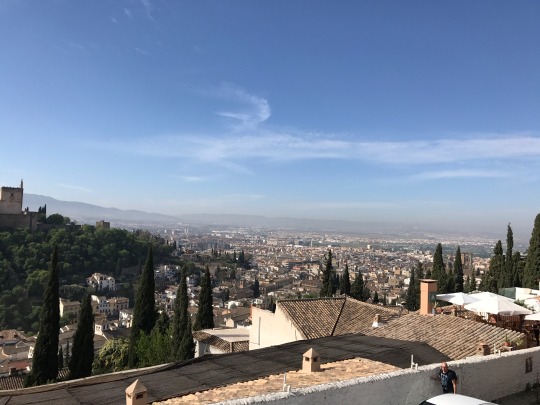



2. SEVILLA

When I arrived at my AirBnB in Sevilla, I was greeted by traditional Andalusian tiling on the stairs and wall. It can be a little much at times, but I still think it’s so pretty!

View from my AirBnB of la Giralda, the bell tower of the Seville Cathedral


Parque de María Luisa


Plaza de España. My pictures simply do not do this place justice. I got here and absolutely fell in love - the plaza is simply beautiful. The ambience is distinctly Spanish and is filled with different sounds: street flamenco dancers and their shoes on mini-tablaos, the clip-clop of horse drawn carriages, the music of street performers, the chatter of castañuelas... I could have stayed there for hours.




Every Spanish province has its own bench/monument in the plaza

I found some Valencians, and we took each other’s picture :)



The view from the rooftop of my AirBnB

Another Semana Santa procession, this time in Sevilla. You should be able to make out the cone hats a bit more clearly in this one

I learned that I had to be very flexible while navigating the streets of Sevilla. Not only were they a virtual labyrinth to begin with, many times I would finally find the right street to follow, only to be forced to turn around because it was blocked off by a procession. This trip was an exercise in patience and flexibility for me in many ways - in this case, instead of getting frustrated, I decided to just relax and enjoy the procession!


Another Virgin effigy



The Cathedral of Seville, the third largest cathedral in the world

El Real Alcázar de Sevilla (the Royal Palace of Seville)















The palace gardens were gorgeous and very peaceful




One of the processions either entering or leaving the cathedral (don’t quite remember which)

Flamenco Show. Unfortunately, there was no photography allowed until the very end. Although most spaniards would never really go out to see a flamenco show (it is almost solely a touristic attraction at this point), this show was performed in authentic style (or at least, that’s what the reviews on TripAdvisor told me!) and the dancers and musicians were very talented.

La Giralda at nighttime

A procession the night before Easter.


Pro tip - if you don’t want to have to pay to tour the cathedral, go to a service!


It’s pretty cool to say I went to Easter mass in the Catedral de Sevilla, the third-largest cathedral in the world!

A procession on Easter Sunday - notice the robes are white today instead of black, symbolizing purity but unfortunately looking even more like klansmen.

Metropol Parasol, an exposition center in Seville.


Ayuntamiento de Sevilla


La Maestranza, or la Plaza de Toros de Sevilla - The bullfighting ring of Seville

After having studied the culture behind bullfights year after year in Spanish classes, I finally got to see one for myself. Even though I had a feeling I wouldn’t like it, I decided I needed to witness a bullfight in order to form an educated opinion.

And... I hated it. I understand that bullfights are traditionally a way to honor the bull, but all I see is suffering and torture. The bull really has no options. If it is docile, it is prodded and goaded into attacking. If it is aggressive, it is tortured and then killed. What a way to spend Easter Sunday - paying to see the Lord’s creatures suffer unnecessarily :(



Although this bullfight had six bulls, I only got through three before I had to leave the stadium.


While I was waiting for my bus to Lisbon, they were filming a movie at the Seville bus station!
3. LISBON
The leg of my trip from Sevilla to Lisbon was by far the longest of my two-week journey, lasting around 8 hours total. I was horrified upon boarding my bus to observe that there was no bathroom located in the back, knowing full well that nothing short of a miracle would allow me to survive 8 hours without being able to use facilities. I did notice a few elderly couples on the bus as well, and figured they would crack before I did. I assumed that if the bus had no restroom, it would have to make rest stops at least every other hour, but 3 hours into the ride it had not stopped once. It wasn’t until a girl got up from her seat and disappeared behind me that I realized the bathroom on board was ingeniously built (disguised) into the side of the rear-exit stairs. Although this location forces you to more or less climb into the lavatory, I was quite relived to realize that there was indeed a bathroom on board. Who would have thought?!
On a more serious note, traveling to Lisbon by bus really helped me realize just how cool the European Union is. Because both Spain and Portugal are part of the Schengen Area, the free-movement zone of the EU, they have no border control. Driving into Portugal was as simple as driving from one state to another in the US. There’s just a “Bem vindo a Portugal” sign and that’s it - you’re in a new country! In fact, I totally forgot I had left Spain, and when the bus driver took a break at a rest stop (this rest stop finally came after I had discovered the on-board bathroom), I accidentally tried to order food in Spanish!
However, speaking Spanish is still of some value in Portugal. I found that if the person I was speaking to didn’t know English, I could still have a jumbled conversation with them if I asked a question in Spanish - I would just recieve a response in Portuguese. Although the two are absolutely separate languages, they share their similarities, and I was surprised at how much Portuguese I could vaguely understand given my knowledge of Spanish. Written Portuguese was even better. I found that when I concentrated too hard on deciphering Portuguese, I psyched myself out, but when I just did a calm skim over the text, I could get the general idea. This was very useful in a wide variety of scenarios, from understanding instructions from my AirBnB host to reading public transit maps.

Praça de Dom Pedro IV (Rocio)




From my observations, Lisbon seemed to rely much more on tram cars than on busses for public transportation.

Some of them were older while a few were more modern

I just had to stop here and get some shots of the laughably difficult-to-navigate roads in center city Lisbon. Between cars, trams, busses, cyclists, and pedestrians, the roads are a mess.

Take this scene for example. A car is trying to go down a street that is completely blocked by two tram cars. This makes a further traffic jam because the car isn’t able to finish its turn, irritating cyclists, all while a pedestrian jaywalks in between the car and trams. Crazy huh?

Cais das Colunas.

Arco da Rua Augusta

Praça do Comércio

Next, I went on the Elevador da Glória - similar to the trams I mentioned earlier, except it scales a mini-mountain. The picture right below is what the elevador is supposed to look like...

but the next picture is what it actually looks like.

Thank you street artists!


The ride was cool and all, but it was majorly overpriced and there wasn’t really anything at the top, so I was a little disappointed.

The street that my AirBnB was on - pretty jam packed with cars, but still pretty. I love all the different brightly colored buildings.

The craziness that is the Rua Augusta
Later that afternoon, I went to Belém (Bethlehem in English), a municipality of Lisbon that was by far my favorite part of my visit to Portugal. I didn’t take any pictures of it, but in order to visit the various monuments I walked through a beautiful park full of happy couples, children running around playing sports, and picnics in the grass. Oddly enough, passing by and enjoying the calm scene hit me with a wave of nostalgia for home - who would have thought a park in Portugal would make me yearn for an American summer?

Mosteiro dos Jerónimos, a beautiful monastery that I admired from the outside because I’m too cheap to pay the entrance fee for everything (and trust me, I had paid enough to enter various religious buildings by that point).






Padrão dos Descobrimentos




Lisbon trying to get that SanFran aesthetic?

Torre de Belém, beautiful at sunset

The next day, I took a short-distance train to Sintra, a famous national park on the outskirts of Lisbon.


Palácio Nacional de Sintra


To walk to the Moorish Castle, I had to hike through some of the forests of Sintra. The pictures truly don’t do the walk justice. On family vacations, I’m normally the one who complains about hiking, but this hike had even me blown away by its natural beauty and great look-out points.




If you look closely, you can see the Moorish Castle (Castelo dos Mouros) on the mountain in the distance. However, I couldn’t hike all the way up to see it, because there was a steep entrance fee and I’m a cheapskate.

The Palácio da Pena. Get ready for a ton of pictures of this one... I just couldn’t help myself. To me, the architecture is absolutely stunning and very original. For this one, I did cave and pay to go inside.





Like... is that incredible or what?!

Look closely to see the village houses out in the distance




If you look closely, you can see the Moorish Castle on top of the mountain.

What is a trip through Europe without unflattering selfies??




(See look I told you, I actually paid to go inside this once!)





After visiting Sintra, I took the train back to center city Lisbon to explore until I had to leave for my flight to Bilbao

Back in center Lisbon near the Praça de Dom Pedro IV. On top of the hill you can faintly make out the Castelo de São Jorge, where I took these next few pictures

The view at the top was magnificent - shame there was no Elevador da Glória to make this (significantly more challenging) ascent






The walk down was great!

The walk back up, not so much...

Igreja de São Vicente de Fora

For my flight to Bilbao, I was very frustrated that the online check-in did not work for me for some reason. I figured this was because I had purchased the flight off a semi-sketchy third-party website with a great deal on tickets. Knowing this, I got to the airport extra early to get in line and check in the old-fashioned way, intentionally leaving plenty of wiggle room even for an international flight just in case there were any problems with my ticket. Little did I know I would have the most incredible luck when I got to the airport.
First, as I was stopping to get something out of my backpack, a sweet random woman came up to me and asked if I would like some chocolates. Her suitcase was overweight and she was trying to get rid of things. Not too bad huh?
The nice happiness-boost from the chocolate lady wore off pretty quickly when I saw the check in line. It was colossal (the airport was busier than normal because of the Easter season) and moving slowly. I tried to check in on my phone and on the digital machines one last time, but still no luck - each time I would just get a message saying I had to go talk with customer service, so I grudgingly joined the humongous line.
I had barely been in line for 5 minutes, however, when a very kind airline employee came up and asked me what I was waiting in line for. Evidently, because there were so many people waiting to talk to customer service and he just happened to not be busy, he was working from the back of the line up to see if he could help customers and reduce the line. I explained that I just needed to check in for my flight, and he asked me to follow him. He accompanied me to another station where he allowed me to completely cut the line, after which he promptly checked me in and printed my boarding passes. He told me that I had actually purchased budget tickets that didn’t include a checked bag (thanks sketchy third-party website), and that I would normally have to go back to customer service to pay to check my suitcase. However, because the customer service line was already way out of hand, he said he would just go against company policy and check my bag for free. I was completely flabbergasted and could not believe my luck. I thanked him profusely as he hurried away to assist another customer. I honestly felt undeserving of such a stroke of good fortune - I had arrived at the airport with time to spare, and surely there was someone in more of a rush who could have used that godsend more than I could have. Either way, I just had to give that mysterious TAP Airlines employee a shoutout - you the real MVP man.
4. BILBAO
I really enjoyed my time in Bilbao. I happened to visit during the week they were doing a sort of “piano project,” where a number of pianos were placed in public spots and anyone could just walk up and play them. I was lucky enough to come across at least four while exploring the city!
Another neat thing about Bilbao (and Basque Country) in general is their language, Basque or Euskera. Words in Basque can be pretty intimidating to pronounce, to say the least. I didn’t think to snap any pictures at the time, but the picture below I found on Google of a street sign gives you a bit of an idea. Thankfully, everyone (or mostly everyone) also speaks Spanish, so I didn’t really run into any trouble.


I think the snapchat caption just about says it all. My AirBnB hosts had to get up early the next morning for work and I had already arrived a bit later than anticipated, and I didn’t want to irritate them even further by waking them up at such an ungodly hour - so I just sucked it up and waited until morning.

Churros and cola-cao, a delicious breakfast (even if it is pretty meager)

Parque de Doña Casilda Iturrizar

El Cachorro (the puppy), a sculpture made of flowers that’s supposed to look like a west highland white terrier. Unfortunately, the flowers were not quite in bloom yet.

The Guggenheim Museum

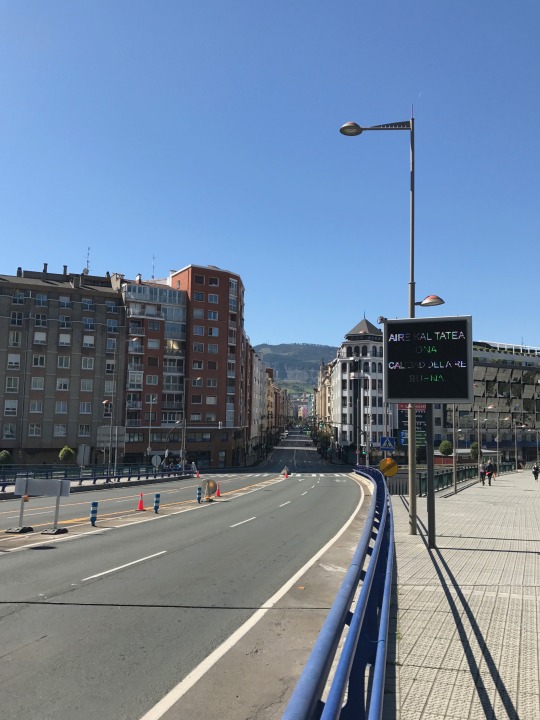

Ayuntamiento de Bilbao

Río Nervión

El Casco Viejo

Catedral de Santiago de Bilbao

Iglesia de San Nicolás

La Alhóndiga. This is a cool one - it’s a multipurpose building in center city Bilbao to serve various needs for city residents. Among other things, it has restaurants, shops, a library, a gym, a movie theater, and an auditorium.
5. SAN SEBASTIÁN
San Sebastián is a very popular beach town to the east of Bilbao. It’s actually quite close to the border with France, and I heard just about as much French spoken while visiting as I did Spanish. Although the water was too cold to swim in and the wind made even laying on the beach a bit chilly for my taste, the city was absolutely beautiful.
To get from Bilbao to San Sebastián was only about an hour ride by bus. When I purchased bus tickets online, I wasn’t really paying too much attention to the type of bus, and €15 seemed a reasonable price to me so I didn’t think anything was out of the usual. However, I was blown away when I saw a sleek black bus that said “ALSA Premium” on it pull up to the station and realized it was for me. This bus was by far the fanciest I’ve ever been on. I mean, it had a flight attendant. On a bus. What? Did I mention complimentary snacks and beverage service? I sure wish I had this bus for my 8 hour ride from Seville to Lisbon! I was almost sad when the ride ended. I found a picture of the bus model online so you can get a better idea.


The Río Urumea, that flows through the city of San Sebastián and into the Bay of Biscay.

El Ayuntamiento de San Sebastián


Playa la Concha




Such amazing artistry - a man down on the beach was drawing all these designs in the sand, and passerby on the bridge where this photo was taken would throw money down for him.




Catedral del Buen Pastor de San Sebastián





Basílica de Santa María del Coro

Iglesia San Vicente

6. MADRID

For the end of my two week traveling spree, I decided to splurge and treat myself a bit by booking a private single room in the cheapest hostel I could find in Madrid, instead of staying in a room in someone else’s house via AirBnb. This was the view from my balcony!

Because Madrid is the most globalized city in Spain, I was overjoyed to find a place where I could get a real, hearty American breakfast (breakfast in Spain is very, very light fare). It was so delicious (or maybe I had just missed real breakfast so much) that I ended up coming back here for breakfast again!

San Jerónimo el Real


Real Jardín Botánico





“I heard it and I forgot / I saw it and I understood / I did it and I learned.”
-Confucius

Parque de El Retiro






Cool spot in the park where you could rent a game of chess!

Puerta de Alcalá

Plaza de Cibeles. This building serves as the town hall of Madrid. Notice the “Refugees Welcome” banner - wishing our president could take a page out of Spain’s book.

Edificio Metrópolis along the Gran Vía

Estatua del Oso y el Madroño. This statue represents the Coat of Arms of Madrid and is also the 0 kilometer mark for all roads in Spain.

Estatua de Carlos III de España in the Puerta del Sol, the Spanish equivalent of Times Square.




Plaza Mayor

Estatua de Felipe III de España






Real Basilica de San Francisco el Grande

Palacio Real de Madrid (Royal Palace of Madrid) seen from a distance.

More pictures of the Palacio Real




Templo de Debod, a temple that was disassembled in Egypt and reassembled in Madrid, now located alongside a nice public park.


Biblioteca Nacional, the Spanish National Library

It’s really cool to me that Spain has a ministry (government department) of equality.

A protest by Venezuelan expats living in Spain, decrying political corruption in Venezuela and trying to raise awareness of their country’s economic crisis.


Las Bicicletas son para el verano (Bicycles are for Summer), a play I read for my Spanish Literature & Cinema class during the semester. I had the chance to see the play live in Madrid!


I was always taught it’s good to arrive to the theater a half-hour early, but here, the other spectators were living up to the stereotypes about Spanish punctuality.

Madrid at nighttime


7. TOLEDO
The last stop on my two-week adventure was Toledo, Spain. The city had a very distinct charm and some absolutely incredible views of mountains and valleys.

I was already impressed with Toledo as soon as I stepped off the train - look at how how pretty the train station is!

Puente de Alcántara

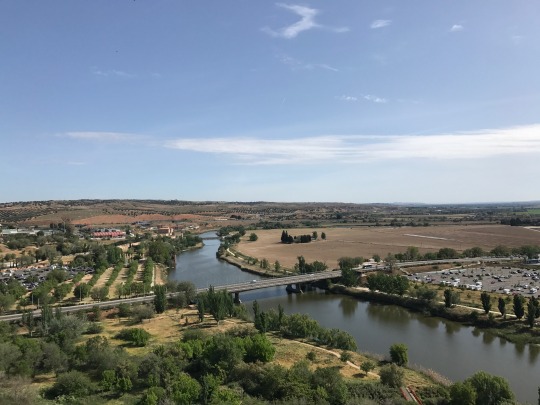


El Alcázar de Toledo



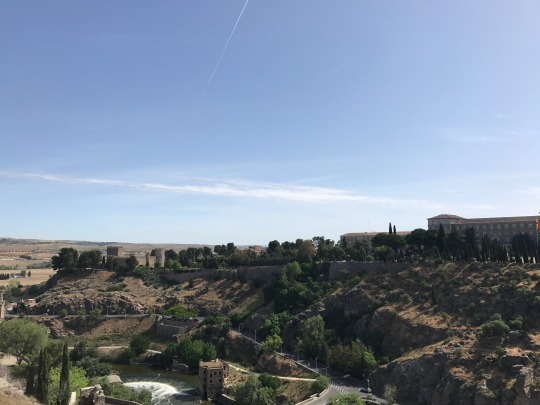


Catedral de Santa María de Toledo




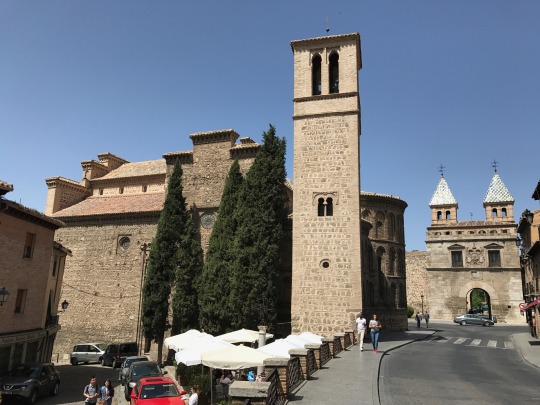

Inside Monasterio de San Juan de los Reyes


Puerta de Bisagra
At this point, I took a very, veeeery roundabout hike (I didn’t really know what I was doing, I was just looking at the maps app on my phone) to try to find the Mirador del Valle, a lookout spot where you can see the whole city of Toledo in all its glory. It was a very hot, sweaty hike, but I finally made it, and the views were totally worth it.





I also found another mini-mountain next to the lookout spot where I could get an even better vantage point of the city, so of course, I climbed it.
If you’ve reached this point in the post, you can smile as wide as I am in that last pic... you’re done! The never-ending blog post is finished. If you actually read all this, you deserve some award.
Although I was sad that my journey finally had to come to an end, upon my return to Valencia was greeted by my wonderful host mom, who stayed up until midnight to make sure I was well-received with a hot home-cooked meal (she’s the best).
This trip was very eye-opening for me in a lot of ways. It was an exercise in maturity to live independently for two weeks, not to mention the absolutely incredible opportunity to see so much of Spain in so little time. Even so, there are many more places I would have liked to visit. I’m already starting my list for round two. Spain, you haven’t seen the last of me!
0 notes
Text
New Post has been published on Cloudlight
New Post has been published on https://cloudlight.biz/session-hijacking-wordpress-malware-spotted/
SESSION HIJACKING WORDPRESS MALWARE SPOTTED
Researchers have identified a pressure of cookie stealing malware injected right into a valid JavaScript file, that masquerades as a WordPress middle domain.
Cesar Anjos, a security analyst at Sucuri, a firm that focuses on WordPress safety, got here throughout the malware at some point of an incident response research and defined it in a blog published Tuesday.
Anjos says it appears attackers used typosquatting
Or URL hijacking, to craft the phony area, code.Wordprssapi[.]com. Typosquatting is a way that typically is predicated on users making typographical errors when inputting URLs into an internet browser. In this case, the fake website is designed to appear to be a legitimate WordPress area so it doesn’t appear out of region within the code.
The researcher stated it seemed attackers injected malware into the lowest of a valid WordPress JavaScript record designed to reroute touchy information, such as cookies, to the faux domain.
Denis Sinegubko, a senior malware researcher at Sucuri, advised Threatpost Wednesday that it’s probably an attacker took gain of any other vulnerability in WordPress to inject the obfuscated code in the first region.
“Modern attacks not often use one particular vulnerability. They commonly experiment for more than one recognized vulnerabilities (commonly in 0.33-birthday celebration issues and plugins) and then make the most anything they locate,” Sinegubko said.
Anjos points out that in addition to appearing at the lowest of a real WordPress JavaScript file – wp-consists of/js/hoverIntent[.]min[.]js – the code additionally uses an ordinary obfuscation sample, eval(characteristic(p,a,c,okay,e,d). The characteristic, usually utilized in JavaScript libraries and scripts, tightly packs code that’s later completed when the web page loads.
Stopping Domain Name Hijacking and Domain Name Theft
Domain hijacking, or area robbery, occurs while someone improperly changes the registration of a website call without permission from the unique registrant. A domain may be hijacked for several motives: to generate cash via a click on through visitors, for resale to the proper owner or a 3rd party, to feature price to a current enterprise, for malicious motives, or to acquire notoriety.
The charges of area hijacking are sizeable. According to Symantec, a security software program organization, in 2012, the financial system misplaced $400 billion as a result of incidents of domain hijacking and related crimes. A variety of domains has been hijacked in current years, together with the U.S. Marines, The New York Times, Twitter, Google, The Huffington Post, Forbes.Com, and Craigslist.
Once a website is hijacked, it’s far hard to get better.
If you observed your domain has been hijacked, immediately touch the organization with whom you registered the domain. To the extent the registrar can affirm your domain has been hijacked, the registrar ought to work to assist transfer the domain call lower back to you. It is uncommon, but, to recover any damages incurred during the period that the domain changed into improperly inside the fingers of a 3rd birthday celebration.
There are few opportunity actions if the registrar does not or can’t act. Both litigation and ICANN court cases can be high priced and time-eating. Neither option may additionally appropriately shield your online commercial enterprise and popularity all through the intending. In a few times, it is able to be less expensive to simply create a new website and register a brand new domain.
Because of the risks associated with area hijacking, it’s far essential that businesses take steps to make any tried hijacking greater difficult. First, make sure that the registrar with whom you check in your area is authentic. There are masses of registrars, so it’s miles crucial to do your studies. You might also consolidate all your domains with one registrar, which simplifies your capability to display all your domain names.
Second, make sure that your touch information is updated. Registrars have a tendency to apply email as the primary method of communication and to reset passwords on your account. If that email lapses for any motive, then a person else can alternate your domain registration greater effortlessly. Consider using an administrative email, so that you don’t ought to update the e-mail whenever the character answerable for the domain call adjustments.
Third, cozy your person names and passwords.
As with other passwords, make your password hard to bet. Limit get admission to best to folks that actually want it.
Fourth, recollect the usage of Whois Privacy Service, which makes your contact data non-public. This option might also have drawbacks, but. For example, it is able to be hard to prove that you are the genuine registrant of the area if this selection is enabled. It may create additional delays in the event that you have to use a criminal process to recover a hijacked domain.
Difference Between Java and WordPress
Java and WordPress are very a whole lot unique, this is an try and compares and spot wherein they intersect every other.
Java
Java is an organization Language, what its approach it’s far used to build organization packages, what do we mean by that?
· A type of clients can interact with programs like browsers, smart capsules, B2B packages, NET and different language apps.
· High Security to guide the requirements.
· Highly Scalable to help the growing site visitors.
· Performance – Begin bring together time performance is high.
· E.G programs are Gaming, ECommerce websites, Billing, Retail, CRM and lots of others
Java may be used to create blogging CMS like WordPress. There are CMS’s like alfresco, Plone, JRoller who do to try to that, however, none has been in a position so famous as WordPress.
WordPress
Very specialized CMS/running a blog engine build on the pinnacle of PHP.
· It is very easy to examine software program, compare it to mastering MS Word.
· You don’t want to realize PHP/programming to be WordPress internet site developer.
· It has a issues idea, which lets in a developer to configure internet site pages with clean.
· Supports hundreds of plugins, nearly clean to discover any kind of functionality an internet site desires.
· Installs on Apache Server with PHP engine.
· Many website hosting websites assist 1 click setup.
· Uses MySQL as the backend engine.
As you spot, WordPress and Java can’t be as compared as one is a language where another is a software built on PHP language.
Had WordPress been written in Java
As a Java Developer, I do want WordPress turned into built on Java, it would have given
1. Java applications an internet aptitude, we would see altogether new set of programs /widgets/ plugins.
2. Designers would have no longer be afraid of the language in any respect.
Three. Applications ought to have used the WordPress database, which has a completely easy schema
Best Ways to Catch a Spotted Seatrout
The first step to apply whilst concentrated on any species of fish is to examine what they like. Spotted seatrout like;
• Grass apartments • Oyster bars • Abundant prey offerings
The satisfactory region to discover a spotted seatrout is by way of ways the grass apartments. These fish inhabit the inshore saltwater estuaries throughout the southern areas of the United States of America. Typically, if you may find a few acres of healthy sea grass, you’ll additionally find trout. Their whole life cycle takes place inside the inshore surroundings. They will usually be stuck in water depths of six feet or less. Sometimes they can be found in water much less than 12 inches deep.
The 2d exceptional inshore surroundings to find your goal species is near an oyster bar. Oyster bars are awesome locations to goal these fish because a wholesome oyster bar is a haven for small shrimp, crabs, and small fish. Large oyster bars are also a first rate environmental indicator for a healthy water device. Oysters do no longer thrive except the waters they are living in are easy and healthy. If you need to goal those fish, you ought to are seeking for out wholesome grass residences or healthy oyster bars.
The third indicator a fisherman need to are trying to find out for capacity noticed seatrout haunts is bait colleges. If you may discover a faculty of any of the subsequent species, you will most likely locate your goal species. Their favorites appear to be shrimp followed carefully by sardines, glass minnows, and pilchards. Larger trout appear to like huge mullet and pinfish offerings excellent.
The three excellent lures to seize a noticed seatrout relies upon the fisherman, but this fisherman prefers the subsequent;
• Scented soft plastics combines with a pink jig head
• Gold spoons • Any imitation mullet lure
Scented gentle plastics used in aggregate with a jig head is that this fisherman’s favored in terms of catching these fish. This species of fish loves to hit the jig in the fall because it covers the water column up and down. When the water is less warm a slower jigging approach and a slower retrieve is essential. When the water temperatures are above 70 ranges a faster retrieve will regularly work higher.
Gold spoons catch just about every fish in the ocean. This ancient fishing trap works thoroughly. They are available in a normal model with a treble hook but they also can be observed with weed fewer versions. A fisherman must determine that is great for the fishing conditions they’re experiencing.
Any imitation mullet trap will catch larger fish. The walk-the-canine sort of mullet imitations paintings quality for this fisherman, however, the suspending and sinking variations may even work well relying upon the water depth. There also are gentle plastic imitation mullet lures in an effort to paintings very well. Just solid this lure right into a faculty a mullet and await the strike.
0 notes
Text
95% off #Coding for Entrepreneurs: Learn Python, Django, and More. – $10
A Programming Class for Non-Technical Founder(s). Learn Django- the #1 Python Frameworks, APIs, HTML, CSS, + Payments.
All Levels, – 45 hours, 251 lectures
Average rating 4.4/5 (4.4 (648 ratings) Instead of using a simple lifetime average, Udemy calculates a course’s star rating by considering a number of different factors such as the number of ratings, the age of ratings, and the likelihood of fraudulent ratings.)
Course requirements:
You don’t already know how to program/code You have a computer that was made after 2006 You have a strong willingness to get through the tough parts You ask questions when you get stuck You research errors on your own, or you ask questions when you get stuck
Course description:
Work Alongside Me & Learn Exactly How To Code An eCommerce Site & A Landing Page From Scratch (Last Updated: Dec-8-2014)
Never coded before? No problem. We’ve worked with over 120,000 students just like you.
Entrepreneurs like you are a rare breed. You create incredible businesses and come up with ideas that change the world.
Technology has made the 21st century, the century of the entrepreneur. Thanks to the power of the internet, you can reach a global audience in minutes.
The question is…do you have the skills to be able to take advantage of this incredible opportunity?
If you’re starting (or have started) a business in today’s tech driven economy, then you’ve got to understand the code that’s driving your business.
Imagine asking others to create your software but you’ve no idea how it works? Imagine not knowing the time and effort involved in realizing your idea? Imagine having an incredible idea but you don’t have the skills to get it started?
Coding For Entrepreneurs Will Teach You, Step-By-Step, Exactly How To Code An eCommerce Website As Well As A Dynamic Landing Page. Over 120,000 students are currently learning from our courses.
All you have to do is follow along with me in a series of easy-to-follow videos that will teach you everything that’s involved in:
Project #1: Building an eCommerce site: This project will take you through everything from setup to execution…but it won’t stop there. You won’t just be watching these videos…you’ll actually build this site yourself.
Project #2: Launch a Landing Page for your project: In this section you’ll learn how to build a landing page from scratch so you can collect customer DATA through a FORM. You’ll then deploy this to a live server, and be ready to collect your customer’s information so that you can test market your idea to them immediately.
When you’re finished these sections, you’ll understand how huge eCommerce sites like Amazon, Zappos, Groupon & Livingsocial were created.
I’m Not Going To Teach You Tons of Coding Languages…
Instead of spending infinity boring you with the intricacies of a multitude of languages, Coding For Entrepreneurs will teach you the exact languages you need to know to launch any type of eCommerce site & build landing pages that convert browsers into buyers.
The best way to learn is by doing – you’ll never learn anything if you sit and watch videos or read a PDF all day. We get you into action and enable you to achieve results immediately.
You’ll become proficient in:
Python Django HTML CSS
Don’t worry if these look scary…if you can multiply and add numbers then you can code!
Coding is extremely logical. Take Python for example – it reads just like the English language less a couple of odd characters (if it doesn’t now, it will soon):
We Put Special Emphasis On Django…Why?
– Django is based in Python – It’s fast, simple, effective, secure, and ideal for “perfectionists with deadlines” – Built-In User Login (authentication) System – Web-based Admin system (built – in) – Template system that allows basic knowledge of HTML/CSS to design the front-end. – Growing Community for Help/Advice/Best Practices …. and freelance clients (or jobs). – Easy to implement & Launch
But I’ve Been Told That I Need To Learn C, C#, Objective C and Java?
The truth is that you could learn all of these languages and use them to further enhance your coding.
But why bother?
You’re an entrepreneur, NOT a professional coder. Would you rather learn how to code something quickly and start building your business empire or spend years debugging something that may never launch?
It’s time to take your future into your own hands and learn how to start Coding For Entrepreneurs today!
How To Be Ultra Successful With This Class
– Watch the videos and follow me and do exactly as I do – If you get stuck, rewind and rewatch while copying me again – If you’re still stuck, ask questio
Reviews:
“Great course, learned so much, great tutor!” (Lee Humphreys)
“The projects included in this course are very detailed, useful, and fun. I appreciate that the instructor devoted so much time and effort into this course. Only problem is that the knowing which version of the projects and code to use was confusing at first. I assumed that because the newest version of Django is Django 10, that the projects would be compatible with them. I was also confused as to how TryDjango 1.09 and 1.10 are quite different from each other as I assumed they would just have minor differences” (Jerry Kim)
“Great step by step course, and you can view real programming with errors that Justin solves in front of your eyes.” (Antonio R. González Bolaño)
About Instructor:
Justin Mitchel
It all started with an idea. I wanted freedom… badly. Freedom from work, freedom from boredom, and, most of all, the freedom to choose. This simple idea grew to define me; it made me become an entrepreneur. As I strived to gain freedom, overtime I realized that with everything that you do you can either (1) convince someone, somehow, to do it with you or (2) figure out how to do it yourself. Due to a lack of financial resources (and probably the ability to convince people to do high quality work for free), I decided to learn. Then learn some more. Then some more. My path of learning website design started a long time ago. And yes, it was out of need not desire. I believed I needed a website for a company that I started. So I learned how to do it. The company died, my skills lived on… and got better and better. It took me a while after learning web design (html/css) to actually start learning programming (web application, storing “data”, user logins, etc). I tinkered with WordPress, believing it could be a “user” site, but I was mistaken. Sure there are/were hacks for that, but they were hacks/work-arounds and simply not-what-wordpress-was-indended-to-be. WordPress is for blogs/content. Plain and simple. I wanted more. I had a web application idea that I thought would change the way restaurants hire their service staff. I tested it with my basic html/css skills, had great initial results, and found a technical (programmer) cofounder as a result. He was awesome. We were featured on CNN. Things looked great. Until… cash-flow was a no-flow. Business? I think not. More like an avid hobby. We had the idea for a business just no business. Naturally, my partner had to find a means of income so I was left with the idea on its own. Remember how I said everything we do has 2 choices. Well I tried the convincing. Now it was time to try the learning. I opted to learn and haven’t looked back since. I tried almost every language out there: PHP, Ruby on Rails, SQL, Objective C, C++, Java, Javascript. I was lost. Then, I tried Python. I was hooked. It was so easy. So simple. So elegant. Then, I tried Django. Even more hooked. Made from python & made for web applications. It powers Instagram & Pinterest (two of the hottest web apps right now?). Then, I tried Bootstrap. Simple and easy front-end design (html & css) that is super easy to use, mobile-ready, and overall… incredible. Python, Django, and Bootstrap are truly changing the way the world builds web applications. I believe it’s because of the simplicity to learn, the sheer power behind them, and, most of all, the plethora of resources to aid anyone in building their web projects (from packages to tutorials to q&a sites). I relaunched my original venture with my new found skills. That wasn’t enough. It didn’t compel me as it once had. I started imagining all the possibilities of all the ideas I’ve always wanted to implement. Now I could. Which one to start with? There were so many good ideas… Then another idea, a new & fresh idea, started brewing. I started to believe in the power of learning these skills. What would it mean if other non-technical entrepreneurs could learn? What would it mean if ideas were executed quickly, revenue models proven, all prior to approaching the highly sought-after programmers? What would it mean if entrepreneurs became coders? And so. Coding for Entrepreneurs was born. Here are some bio highlights:
Instructor Other Courses:
Tweetme | Build a Twitter-like app step by step with Django Justin Mitchel, Coding Entrepreneur & Teacher (64) $10 $195 Homebaked | Raspberry Pi + Django Home Server Django Core | A Reference Guide to Core Django Concepts …………………………………………………………… Justin Mitchel coupons Development course coupon Udemy Development course coupon Web Development course coupon Udemy Web Development course coupon Coding for Entrepreneurs: Learn Python, Django, and More. Coding for Entrepreneurs: Learn Python, Django, and More. course coupon Coding for Entrepreneurs: Learn Python, Django, and More. coupon coupons
The post 95% off #Coding for Entrepreneurs: Learn Python, Django, and More. – $10 appeared first on Udemy Cupón/ Udemy Coupon/.
from Udemy Cupón/ Udemy Coupon/ http://coursetag.com/udemy/coupon/95-off-coding-for-entrepreneurs-learn-python-django-and-more-10/ from Course Tag https://coursetagcom.tumblr.com/post/155572203643
0 notes